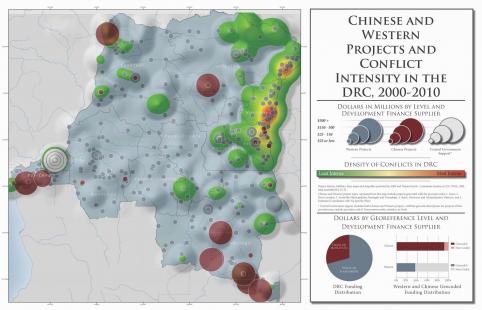Chinese development finance to Africa remains difficult to track, as the Chinese government does not publish comprehensive data on how or where it allocates such funding. Additionally, China provides development finance through diverse modalities, many of which are fundamentally different from the aid flows provided by “traditional” Western donors. AidData’s Tracking Under-Reported Financial Flows (TUFF) methodology is attempting to address this critical information gap. Given China’s role as a leading “non-traditional” donor — and its apparent disinterest in disclosing detailed data on its overseas activities — the need for reliable and comprehensive data is clear and compelling. Without such data, it will be difficult to understand the effects of aid and other “non-traditional flows” from China to developing countries.
Several AidData researchers recently published a working paper entitled, “Tracking Under-Reported Financial Flows: China’s Development Finance and the Aid-Conflict Nexus Revisited” (Strange et al. 2014). The paper explores both the nature of the TUFF database as well as its application in determining how Chinese development finance impacts countries that are prone to conflict and that experience sudden “shocks,” or withdrawals, of aid from “traditional” donors. While the relationship between aid and conflict has been studied extensively, the body of literature draws primarily on analysis of Western donors. For example, a recent study, entitled “Foreign Aid Shocks as a Cause of Violent Armed Conflict” and published in the American Journal of Political Science, found that when “traditional” donors abruptly decrease their aid contributions, this shock increases the likelihood of conflict onset within countries (Nielsen et al. 2011).

This map examines Chinese and western funded projects and the presence of conflict in the Democratic Republic of the Congo. Source: china.aiddata.org.
Nielsen et al. found that an unexpected drop in aid disbursements to a particular country increased the likelihood that the country would experience an outbreak of violent conflict. The authors argue that the causal mechanism explaining this finding relates to elites’ ability to use aid revenue to consolidate domestic support. Strange et. al. (2014) build upon these findings. They seek to analyze whether access to funding from China plays a stabilizing role in developing countries that face sudden withdrawals of “traditional” aid. Their empirical results indicate that when “traditional” donors generate aid shocks to African countries, those countries having access to substantial Chinese development finance are significantly less likely to face conflict. Specifically, aid shocks do not translate into conflict when the value of the Chinese official finance reaches one percent of the recipient’s Gross National Income (GNI). The authors conclude that instead of Chinese development finance having a damaging effect on African governance, it can also have a stabilizing effect on weak governments.
